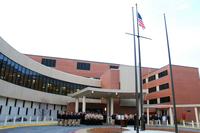The U.S. Navy plans to outfit destroyers with a next-generation radar that is far more powerful in detecting and locating potential threats than the system on ships today, service officials said.
The Air and Missile Defense Radar, or AMDR, now in development and slated for integration on ships by 2016, is part of a series of technological upgrades in what the Navy calls Flight III modernization increments for its fleet of DDG 51 Arleigh Burke-class of destroyers.
In radar terminology, a 15-decibel increase with AMDR translates into roughly 35 times more power and sensitivity compared to the existing AN/SPY-1D radar, according to Capt. Mark Vandroff, program manager for DDG-51 acquisition. While it is being engineered to conduct a range of multi-mission radar functions, the AMDR will primarily function as an anti-air and anti-ballistic missile detection system, he said.
“It is a major leap forward in radar technology," Vandroff said in an interview with Military.com.
The Navy has 62 destroyers, with four more being built and up to 10 new DDGs on order.
AMDR consists of S-band and X-band radars and a radar suite controller. Together, the technologies are able to scan, track and search the horizon and surrounding area for threats by sending an electromagnetic signal into the atmosphere, then analyzing the return signal of what it hits. The information can provide dimensions of a missile or other incoming threat by identifying its size, shape, location and trajectory.
Similar to its predecessor, the Aegis AN/SPY-1D radar, the AMDR includes a phased-array radar, Navy officials said. The S-band radar is engineered for long-range detection, whereas the X-band radar performs the over-the-horizon search capability, according to the service. “AMDR is really optimized for the anti-air and ballistic missile defense regimes but it is capable in the anti-surface and counter-battery,” Vandroff said.
Much like today’s AN/SPY-1D radar, the AMDR will be able to scan the surface as well, assisting with the fire-control technology needed to identify where an incoming threat can be intercepted, he said.
The AMDR radar is performing very well in its current technology development phase. However, the Navy is immersed in a series of technological adjustments, known as engineering change proposals, needed for the DDG-51s to accommodate the new radar, Vandroff said.
“In order for the ship to accommodate the AMDR radar, I would need more power and more cooling," he said.
In particular, the changes include upgrading the existing DDG 51’s 200-ton air conditioning plant to a 300-ton plant, Vandroff said. A ton of cooling is a standard unit of cooling indicating how much heat exchange is required to lower temperatures by one degree over a certain period of time, he said.
A 300-ton plant is undergoing qualification testing to ensure it's ready for integration in a military and marine environment, Vandroff said. The testing designed to evaluate the equipment's ability to survive a shock event, vibrations of being on a ship for years and electromagnetic interference from other rotating equipment, he said.
While Vandroff said he was confident in the development of the 300-ton AC plant, the current 200-ton AC plant has shown it can accept additional cooling capacity as well.
The engineering change will also boost the electrical capacity of the ship’s generator from three megawatts to four megawatts to fully support the power demands of the AMDR radar, he said.








